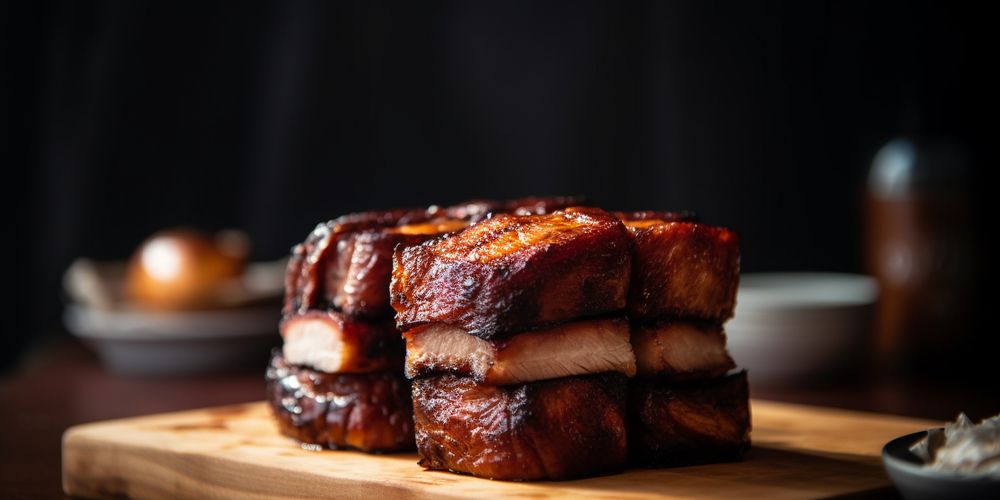
Why BBQ Pork Belly is a Great Idea
BBQ pork belly is a popular dish in many cultures, and for good reason! Pork belly is a flavorful and fatty cut of meat that’s perfect for slow cooking, and when combined with a smoky BBQ sauce, it becomes a mouthwatering and irresistible dish. The combination of juicy and tender meat, crispy and caramelized skin, and a smoky and delicious BBQ flavor is simply unbeatable. Plus, it’s easy to make and perfect for a summer BBQ or any occasion.
Ingredients
- 1 kg pork belly
- 2 tbsp brown sugar
- 2 tbsp paprika
- 1 tbsp garlic powder
- 1 tbsp onion powder
- 1 tsp salt
- 1/2 tsp black pepper
- 1/2 cup BBQ sauce
Instructions
- Preheat your oven to 160°C.
- Mix the brown sugar, paprika, garlic powder, onion powder, salt, and black pepper in a bowl to make the dry rub.
- Rub the dry rub generously all over the pork belly, making sure to coat the entire surface.
- Place the pork belly in a baking dish, skin-side up.
- Cover the pork belly tightly with foil and bake for 2 hours.
- Increase the oven temperature to 220°C.
- Remove the foil and brush the BBQ sauce all over the pork belly.
- Return the pork belly to the oven and bake for an additional 30 minutes, or until the skin is crispy and caramelized.
- Remove from the oven and allow to rest for 10 minutes before slicing and serving.
Variations
- Spicy BBQ Pork Belly: Add some cayenne pepper or red pepper flakes to the dry rub for an extra kick.
- Asian-style BBQ Pork Belly: Use soy sauce, honey, and ginger in the BBQ sauce and serve with steamed rice and bok choy.
- Low-carb BBQ Pork Belly: Use a low-carb BBQ sauce and skip the brown sugar in the dry rub.
- Vegetarian BBQ Pork Belly: Substitute the pork belly with sliced eggplant or tofu, and use a vegan BBQ sauce.
- Keto BBQ Pork Belly: Use a sugar-free BBQ sauce and skip the brown sugar in the dry rub.
BBQ pork belly is a versatile dish that can be customized to suit different tastes and dietary needs. Whether you prefer it spicy, sweet, or smoky, there’s a variation for everyone. Give this recipe a try and impress your family and friends with your BBQ skills!
FAQ
What is pork belly?
Pork belly is a boneless cut of fatty meat from the belly of a pig. It is often used in dishes like bacon, pancetta, and pork belly sliders.
What is the best way to cook pork belly?
There are many ways to cook pork belly, but for BBQ pork belly, we recommend slow roasting it in the oven or smoking it on a BBQ grill.
How long should I marinate the pork belly?
For best results, marinate the pork belly for at least 4 hours, but preferably overnight. This will allow the flavors to penetrate the meat and make it more tender.
What should I serve with BBQ pork belly?
BBQ pork belly pairs well with a variety of sides, including coleslaw, corn on the cob, baked beans, and potato salad.
Can I use a gas grill instead of a charcoal grill?
Yes, you can use a gas grill instead of a charcoal grill for BBQ pork belly. However, you may need to adjust the cooking time and temperature to achieve the desired level of smokiness.
How do I know when the pork belly is done cooking?
The internal temperature of the pork belly should reach 145°F (63°C) to be considered safe to eat. However, for a more tender and juicy pork belly, you may want to cook it to an internal temperature of 190°F (88°C).
Should I remove the skin from the pork belly before cooking?
It is a matter of personal preference whether to remove the skin from the pork belly before cooking. The skin can help keep the meat moist and add flavor, but some people prefer to remove it for a crispier texture.
Can I freeze leftover BBQ pork belly?
Yes, you can freeze leftover BBQ pork belly for up to 3 months. To reheat, thaw the pork belly in the refrigerator overnight and then bake it in the oven or grill it until it is heated through.
What is the best way to slice the pork belly?
For best results, slice the pork belly against the grain into thin strips. This will help make the meat more tender and easier to eat.
Can I use this recipe for other cuts of pork?
Yes, you can use this recipe for other cuts of pork, such as pork shoulder or pork loin. However, cooking times may vary depending on the cut of meat and the size of the piece.



